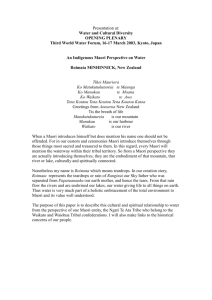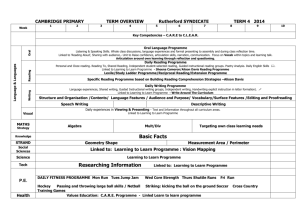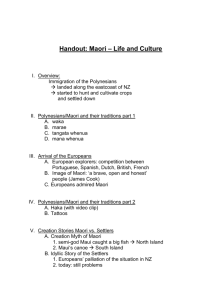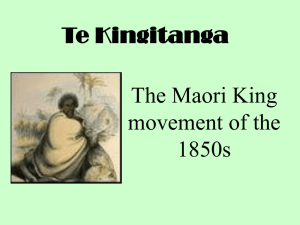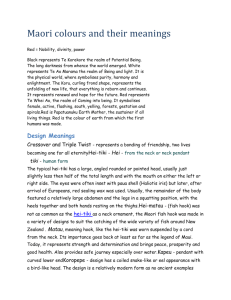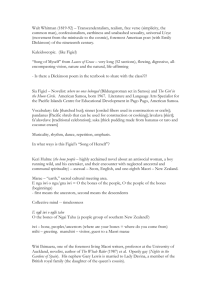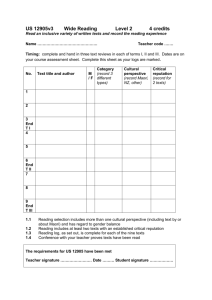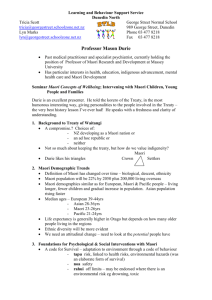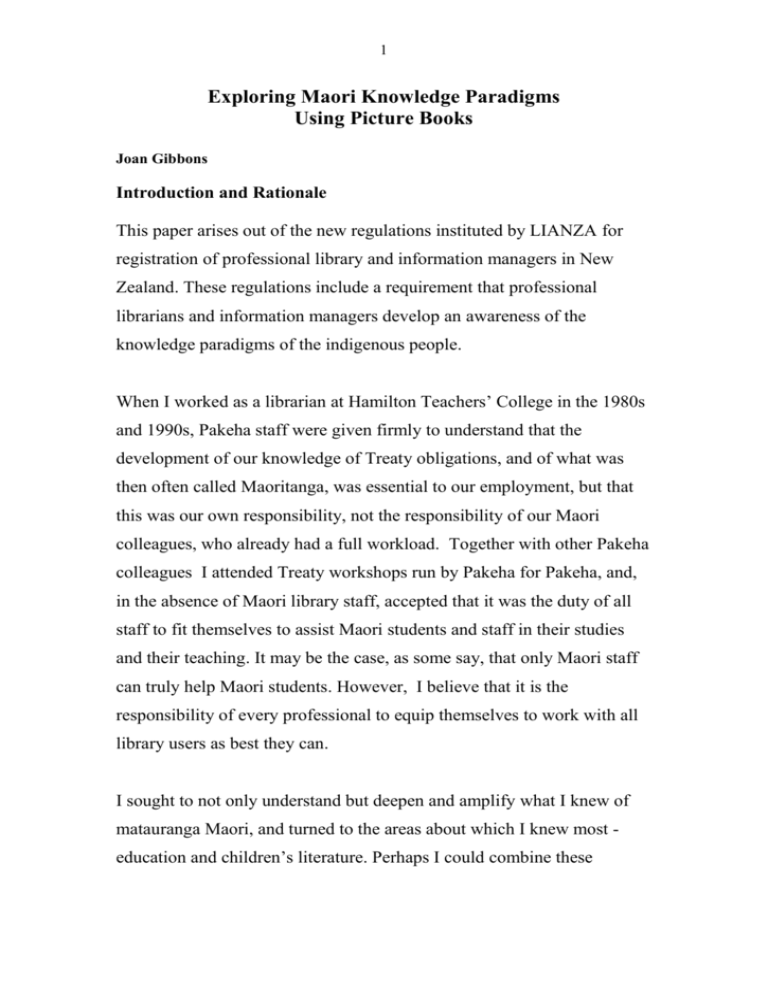
1
Exploring Maori Knowledge Paradigms
Using Picture Books
Joan Gibbons
Introduction and Rationale
This paper arises out of the new regulations instituted by LIANZA for
registration of professional library and information managers in New
Zealand. These regulations include a requirement that professional
librarians and information managers develop an awareness of the
knowledge paradigms of the indigenous people.
When I worked as a librarian at Hamilton Teachers’ College in the 1980s
and 1990s, Pakeha staff were given firmly to understand that the
development of our knowledge of Treaty obligations, and of what was
then often called Maoritanga, was essential to our employment, but that
this was our own responsibility, not the responsibility of our Maori
colleagues, who already had a full workload. Together with other Pakeha
colleagues I attended Treaty workshops run by Pakeha for Pakeha, and,
in the absence of Maori library staff, accepted that it was the duty of all
staff to fit themselves to assist Maori students and staff in their studies
and their teaching. It may be the case, as some say, that only Maori staff
can truly help Maori students. However, I believe that it is the
responsibility of every professional to equip themselves to work with all
library users as best they can.
I sought to not only understand but deepen and amplify what I knew of
matauranga Maori, and turned to the areas about which I knew most education and children’s literature. Perhaps I could combine these
2
particular interests to extend my own knowledge of Maori ways of
knowing.
The task proved, of course, much more difficult than I had initially
thought. The sheer complexity of Maori knowledge, the multiple
meanings of words and concepts in te reo, and the mix of spiritual and
material in all aspects of life, meant that this was bound to be the case. As
Ngoi Pewhairangi has said, “There is so much tapu connected with the
whole culture that I don’t think Pakehas can absorb it” (Manihera,
Pewhairangi & Rangihau, 1992, p. 11). Still, this does not release Pakeha
from the obligation to try.
Methodology
There are a number of sources on Maori life and culture written by Maori
that are well known and readily available. A significant collection of
Maori viewpoints is presented in Te Ao Hurihuri: Aspects of Maoritanga
(King, 1992). I recall listening to an inspiring address from Rangimarie
Rose Pere at a New Zealand Reading Association conference some years
ago (Pere, 2002), and I found her Ako: Concepts and Learning in the
Maori Tradition (Pere, 1982) a valuable resource. I re-read Maori
Pedagogies by Hemara (2000). In addition, I found Exploring Maori
Values, a work by Pakeha philosopher John Patterson (1992) quite useful,
particularly as he is coming from a similar position from me, as a Pakeha
endeavouring to understand Maori ways of thinking. I also used Tangata:
The Human Person, by Michael Shirres (1997).
In a very influential statement, John Rangihau (1992) establishes the
importance of the background of the researcher in relation to Maori
knowledge. He says his feelings are “Tuhoetanga rather than Maoritanga.
3
My being Maori is absolutely dependent on my history as a Tuhoe person
as against being a Maori person.” I understand about being Tuhoe, rather
than undifferentiated Maori, because I am an immigrant from Yorkshire,
rather than being simply English. Moreover, I am from Whitby on the
North Yorkshire coast, not from one of those south west Yorkshire cities
like Huddersfield or Leeds. Rangihau echoes Rose Pere’s (1982) caution
that it is always necessary when discussing Maori knowledge to
remember that there are tribal knowledges rather than one single Maori
knowledge. This sits easily with my own academic understanding that
there are histories, rather than one history.
Armed with Te Ao Hurihuri (King, 1992), Rose Pere’s (1982) Ako, and
Hemara’s (2000) Pedagogies, together with the works by Patterson
(1992), and Shirres (1997), I investigated the New Zealand children’s
literature that I knew. As well, on the recommendation of Pere, Walker
(1992; 2004), and Ka’ai, Moorfield, Reilly and Mosley (2004), and
following up on suggestions by Patterson, I also read or re-read many of
the published versions of Maori myth for children. I considered how
these books presented a matauranga Maori to Pakeha. The picture books I
selected for analysis are written by Maori authors and nearly all are
illustrated by Maori. They are largely published for a non-Maori
readership.
There are a number of concepts that are especially important to a pakeha
in seeking to understand Maori knowledge. Below, I discuss some of
these concepts, and suggest how certain English language picture books
exemplifythese concepts or can add to our understanding of them.
Patterson (1992) talks about “exploring” Maori concepts
4
to convey the idea of an outsider, who is in a position of relative
ignorance, approaching unfamiliar territory. Realising that one has
little or no understanding is an important first step. Another
important step is to realise that understanding is a matter of degree –
that however well a Pakeha may come to understand Maori values,
there will always be room for improvement, for further fruitful
exploration (p. 9).
Matauranga Maori
Pere (1982) says that matauranga was the word chosen by the New
Zealand Department (now Ministry) of Education to depict and interpret
the English term, “education”. It can mean, she says, any of the
following: “to know something, to learn or acquire skills, to be
acquainted with, to have some understanding, or to be certain of. But
whatever the context”, Pere adds, “matauranga is not seen as something
that is static or isolated” (p. 73). Thus, multiple meanings and layers of
meaning are very common in te reo Maori.
Pere (1982) writes of the four generations that she slept, ate, worked and
learnt alongside as she grew up (p. 3). From these whanaunga, or
relatives, she learnt what she needed to know to participate in adult life
(p. 4). Such intergenerational learning is depicted in the picture book
Kimi and the Watermelon (Smith, 1978), and in The Kuia and the Spider
(Grace, 1981). Kimi belongs to and contributes to the land, alongside her
grandmother and uncle. She has feelings of wellbeing when her whanau
are around; she communicates these feelings, and also her sadness when
her uncle’s absence is prolonged.
5
In their accounts of Maori culture, both Pere (1982) and Hemara (2000)
place students and teachers at the centre of the educative process, and
they claim lifelong learning as an expectation of Maori. Both say
intergenerational learning was normal, and that students undertook
gradual learning from familiar starting points. Educators may identify
concepts similar to Vygotsky’s scaffolding, and constructivism. Other
aspects Hemara (2000, p. 5) suggests are important to Maori learning are
mixed and complementary curricula, recognition and encouragement of
giftedness, learning and teaching conducted from students’ strengths,
small student numbers and considerable one-to-one interaction (kanohi ki
te kanohi).
The New Zealand early childhood education curriculum, Te Whariki
(Ministry of Education, 1996; Hemara, 2000, p. 67), acknowledges Maori
theories of learning, identifying five strands:
Mana Atua, or wellbeing;
Mana Whenua, belonging;
Mana Tangata, contribution;
Mana Reo, communication;
Mana Aoturoa, exploration.
These strands can often be identified in New Zealand picture books with
Maori themes.
The Three Baskets of Knowledge
Most New Zealand librarians and educators have heard of the three
baskets of knowledge. These, along with two small stones, were brought
back by Tane when he returned from his climb to the highest heaven after
his parents were separated. The names of the baskets vary, but they are
often referred to as te kete aronui, te kete tauri, and te kete tuatea.
6
The first, te kete aronui, contains the knowledge of our senses: what we
experience in the world before us, the natural world apprehended by our
senses.
The second basket, te kete tauri, provides our understanding of what lies
beyond our sensory experiences, the complex patterns of energy which
operate behind our sense perceptions, the realities behind the colours,
shapes, smells and sounds we perceive. It is the knowledge of “the real
world”, but a world of cosmic processes and rhythmic patterns of energy
which uphold and sustain life. Shirres (1997) gives as an example the
way in which the world is both bigger and smaller than the one we knew
in childhood. The material world and the spiritual world are intimately
connected in the Maori world view (Shirres, 1997, p. 17). We can be
nothing and do nothing without mana, or power (Shirres, 1997, p. 18). It
may come from whenua, the land, tangata, our bond with people, or atua,
our bond with spiritual powers. Many Maori stories, including the Maui
stories, involve mana. Patterson (1992) shows how Maui’s trickery and
deceit is legitimised by its success in increasing his mana. As a youngest
son, his mana can only be increased by achieving such success.
The third basket, te kete tuatea, is the experience we have of our
connections with one another and with the past, the knowledge of our
spiritual realities, realities beyond space and time, and the world we
experience through ritual.
In Haere: Farewell, Jack, Farewell, sensitively illustrated by Huhana
Smith, Tim Tipene (2005) demonstrates certain aspects of the baskets of
knowledge. The first part of the book depicts the death of Koro Jack. The
7
spirits are illustrated in the sky, manifesting themselves near what looks
like an old Maori Affairs house in the country; “state houses” of that time
are readily identifiable. The shadows of ancestors are to be seen inside
the house. Ancestors provide protection, as Tilly Reedy comments:
“My ancestors are always there as part of the environment of this
spiritual force, yet quite separate and identifiable” (Reedy, 1979, p.
43, cited in Patterson, 1992, p. 80).
One scholar has noted that “there is true continuity in the concept of the
tipuna, for this word unites in it all the generations which have set up and
still set up the standards by which the kinship group lives” (Johansen,
1954, p. 172, cited in Patterson, 1992, p. 80).
The body of Koro Jack is shown surrounded by a thick veil,
demonstrating cosmic presences in the real world, and his departing
spirit. The spirit is a divine spark, or mauri ora, “which represent’s man’s
true vitality” (Patterson, 1992, p. 84). The concept of hau, or breath, is
involved here, too. Tapu must be observed; and tikanga, or protocols,
require things to be done in the proper order and at the proper time.
Haere demonstrates in graphic form the connections between the present
and the past; spiritual realities are represented and experienced. Amongst
those present at the tangi is the young storyteller’s sister, who is hapu, or
pregnant. Koro Jack’s friends talk about his past, bringing it into the
present. The stories make people laugh and cry. Then he is buried: “With
his tupuna now”, says Nana.
The scene in the book changes to spring, and baby Jack is born. The
whanau gather around once more, this time to celebrate a new beginning.
8
Now only the natural world is depicted; the stars shine where before the
spirits moved. What we see depicted echoes the Christian nativity scene.
Then experiences of birth and death are connected by the visit of the
women to the urupa, and they show baby Jack where Koro Jack is buried.
The whole story is very moving, and it incorporates many aspects of
Maori knowledge and wisdom.
Pere (1982) says “Mauri can pertain to the life principle and the ethos of
animate and inanimate things” and to
the talisman, the physical symbol of the hidden principle that
protects vitality, fruitfulness, the psyche, etcetera, of people, lands,
forests, buildings and so on. It might refer to a person, mauri o te
tangata, a house, mauri o te whare, the marae-atea, a summons,
mauri o te karanga, speechmaking (mauri o te whaikorero, or special
food, mauri o te kumera. (Pere, p. 32)
People’s self esteem relates to their mauri. Maori self esteem may relate
to the group, or whanau, as well as to an individual. In Haere, these
matters are clearly visible; we see a powerful mauri.
Wairua: Spirituality
Rose Pere (1982) has summarised some important Maori perceptions of
wairua, or spirituality. She says that Maori “saw the physical realm as
being immersed and integrated with the spiritual realm” (p. 13). In
addition, says Pere, “A powerful belief in supernatural forces governed
and influenced the way one interacted with other people and related to the
environment” (p. 14). She adds that “Maori recognised ‘Atua’ (spiritual
beings with supernatural influences)”, what Pakeha call gods.
9
Tangihanga-hahunga deals with the ceremonial surrounding the physical
death of a person. Sometimes people give instructions and prepare for
their death. They may pass on the mana pertaining to spiritual power that
has come through the descent line (Pere, 1982, p. 36). Kaitiaki or
guardians, either physical or spiritual, and tohu, omens, were present as
well as atua. These presences are made explicit in Haere: Farewell, Jack,
Farewell.
Waiora refers to health and total well-being. The wairua (spirit) is
emplanted in the embryo from the time it begins to assume form.
Spirituality was inherent in the development of a new life (Pere, p. 59).
Waiora, Pere comments, “included the intellectual, physical, emotional
and psychic development of a child” (Pere, p. 60). The presence of a new
life in Haere is significant. We see this again in a picture book which is
designed for even younger children, Kehua by Robyn Kahukiwa (1996).
Kehua explores a young child’s fear of kehua, or ghosts. She sees a kehua
in the passage of her house when it is dark. She cannot see it when the
light is on, or in the daytime, and wonders where it goes. Most of the
family is too busy to help, but although Nanny is also busy, she finds
time to talk with her mokopuna, and to go with her to the passageway.
When Nanny turns the light off, the kehua appears on the wall behind the
pot plant. Nanny helps the child turn the light on again, so that she can
herself make the kehua disappear. The next day Nanny calls in the
relatives and they “karakia to make that old kehua leave”. Then Nanny
puts a stool under the light switch so that the child can turn the light on
herself. The child’s fears are taken seriously, and steps are taken to
eliminate the fear. The steps taken are both spiritual and practical – the
summoning of the whanau for karakia, and the placement of the stool so
10
that the child can turn on the light. Again, knowledge from the first and
second baskets is combined for a successful outcome.
Kehua demonstrates how children develop an appreciation of their
inherent spirituality through being exposed to karakia, or to people
talking about their own spiritual experiences as part of everyday living
(Pere, p. 60).
Whakapapa: Connections from the beginning
Pakeha New Zealanders generally know of the importance of whanau in
Maori culture. This sense of family, of belonging to a group, also relates
to the significance of whakapapa (Orbell, 1996, p. 120). Whakapapa
involves emphasising “Papatuanuku, and the reciting of things in order,
including genealogy” (Pere, 1982, p. 8). It is often particularly the firstborn of each generation who is expected to know the whakapapa and be
familiar with the names of tribal meeting houses (Pere, p. 27). Various
authorities (Pere, 1982; Orbell, 1997) relate the creation myth, “the early
history of the world”, to the establishment of “natural and proper
behaviour, the tikanga of all ... beings” (Orbell, p. 120). All beings,
because “all tikanga have a common origin in history”; no distinction is
made between people and other living things. The interconnectedness of
all life is emphasized in another picture book, The Kuia and the Spider,
written by Patricia Grace (1981) and illustrated by Robyn Kahukiwa. All
beings have a common origin, a kinship that creates an “underlying
harmony in the world” (Orbell, p. 120). Inevitably “there is conflict as
well, and the myths explain the reason for this” (p. 120).
Rose Pere (1982) suggests that the importance of being close to relatives
originates in the story of Papatuanuku and Rangi-nui-e-tuihi-nei, who, in
11
their “natural beautiful relationship” kept their children close to them
(Pere, pp. 8-9). The children resented “being so confined and restricted
within the closeness and the darkness of the parental union” (p. 9) and, as
all children inevitably do, they sought independence. I considered several
picture book versions of the creation story, such as those by Gossage
(2001) and Hyland (1998), and found Gavin Bishop’s (2009) version in
Counting the Stars to be the most comprehensive in terms of telling
readers about the meaning behind what happened.
Shirres (1997), in his book Tangata: The Human Person, relates the
traditional Maori belief
that the whole of creation is a dynamic movement i te kore, ki te
po, ki te marama, ‘out of nothingness, into the night, into the world
of light’ (p. 16).
In “Mother Earth and Father Sky”, the first story in Counting the Stars,
Gavin Bishop (2009) puts it simply as a progression from nothingness, to
darkness, to light (p. 4), but the light is “blotted out” by the growth of
Papatuanuku and Ranginui, “who spent all of their time cuddled up
together” (p. 5).
Some scholars have stressed how this story indicates the importance of
children growing up, and growing away from their parents. In Maori
knowledge, there is a tension between respect for elders, particularly
respect for the mana of elders, and the need to grow up and acquire your
own mana.
People identify themselves with the different spiritual powers as they
participate in the movement of the universe. It is from these spiritual
12
powers that we receive our worth, our intrinsic tapu, and our power, or
mana, to carry out our role as a human being (Shirres, 1997, p. 28).
When the children of Rangi and Papa see a flash of daylight under
Ranginui’s armpit, they yearn to separate their parents and live in the
sunlight. Tawhirimatea, the god of winds and storms, resists because his
parents are happy together, but the other children say this is because he
already has freedom to blow where he wishes. They long, as all growing
children do, for freedom to be themselves.
Each son acts according to his temperament, and these roles say
something about what was important to Maori. Tumatauenga, who
becomes the god of war and of man, wants to attack and kill their parents.
Patterson discusses the importance of the concept of balance in Maori
knowledge, which results in Tu being the representative of both war and
man. Tanemahuta says no, they “need Mother Earth for somewhere to
live” (p. 8). He consequently becomes the guardian of the forest, the god
of the forest and the birds.
Rongomatane became the personification and origin of agriculture,
gardens and peaceful pursuits. He promoted peace, hospitality, growth,
and things beneficial to humanity. Tangaroa became guardian of the sea
and the fruits of the ocean. Sometimes creatures such as whales, sharks,
and octopus are seen as kaitiaki, guardians or protectors (Pere, 1982, p.
16). Haumiatiketike became guardian of wild and uncultivated food. He
stands for fern roots, vegetables, and the provision of food, and also for
peace and life-giving pursuits.
13
Except for Tawhirimatea, all of them try to separate their parents, but it is
Tane who is successful in separating them and letting in the light.
Ranginui’s tears fall as rain, and Papatunuku’s mist rises as they separate.
The sun comes out, and all the brothers rejoice except for Tawhirimatea,
who, in his outrage, calls up the winds, becomes a hurricane, and roars
“through Tanemahuta’s forest, tearing up trees and tossing them to the
ground” (p. 14). “He churned the sea into whirlpools,” frightening the sea
creatures. “Some went onto the land and became reptiles. Some stayed in
the sea and became fish” (p. 15). Tangaroa reacts by attacking the land,
causing erosion of cliffs and clefts in beaches. Tawhirimatea went on to
attack Tumatauenga, “but the god of war was too strong” (p. 15).
“Tumatauenga wanted to punish his brothers for not helping him” (p. 16).
Although Tu gained mastery over Tangaroa, Haumea, Rongo and Tane,
eating the fish, fern root, kumara and birds, he was not able to master the
winds and the storms. By eating them, he ate his brothers, in revenge for
their allowing him to fight alone against Tawhiri and Papa (Shirres, 1997,
p. 34).
Later, when everything had calmed down, “Tanemahuta threw a cloak of
trees over his mother’s body” and made homes in their branches for birds.
He spun a cloak of stars for his father, so many “that the children of
Ranginui and Papatuanuku could not count them all” (p. 19). And those
children, in the way of myths, are all of us, not just their direct sons. Pere
(1998) suggests that we think of these “gods” as personifications of the
things they represent, and this may help people with definite religious
views of their own to understand the story that is being told.
14
Bishop’s (2009) version of this story shows the parts played by each of
the brothers in opening up the world so that it could be used by nature
and by humanity. The natural world is apprehended by our senses, as in te
kete aronui. It shows the stress that is caused by change, and the different
ways in which people react to change in their condition, as in te kete
tauri. The changes are cosmic in nature, but because of the
personifications, we get the sense that it is the feelings or emotions of
people that are being talked about as well. The story displays family
rivalries as well as family cooperation, and it demonstrates compassion.
There is also te kete tuatea, our knowledge of the spiritual, our awareness
of life’s forces and cosmic forces around us.
Gender roles
There were male and female spiritual presences, reflecting both similar
and complementary roles. For example, Hine-te-iwaiwa presided over
childbirth and the art forms involved in weaving (p. 15). She is also
associated with other personifications from both the land and the ocean
(p. 15).
Maori did not make the differentiation between practical and intellectual
matters that is made in many other societies. Patterson (1992) writes in a
chapter entitled “Respect, Balance and Survival” (pp. 17-45) about
weaving as an example of the Maori philosophy of respect for the natural
world, respect for materials, respect for doing things correctly and
following proper procedures, and respect for beauty.
A book that presents very clearly these aspects of Maori knowledge is
Gavin Bishop’s Hinepau (1993). Hinepau, a woman with sunset hair and
pounamu eyes, lived alone, sometimes speaking “only to the wind”. She
15
had been cast out by her whanau: because of her strange appearance and
her distinctively inside-out weaving they thought she was a witch. She
did not do her weaving as it ought to be done, so she was cast out, lest she
bring disaster upon the tribe. But she always said karakia as she folded
the patterns of the environment into her weaving. As Ngoi Pewhairangi
(1992) states, preparing things correctly involves the laws of tapu, which
teach you to respect the whole of nature (p. 10). Hinepau breaks some of
these rules, and although it is her disobedience of the laws that allows her
to rectify someone else’s wrong, she still has to suffer the consequences.
When some young men come by to cut totara for a new wharenui, she
asks where the tohunga is who will say proper karakia. The young men
are arrogant, and think karakia unnecessary. When the wharenui is
finished, an old woman warns that the gods are not pleased: the wharenui
has been built without the blessing of Tane Mahuta. That night the old
volcano, Maungariri, shakes in anger, and throws a cloak of deadly ash
over the forests, lakes, and rivers. The people inside the wharenui are
spared, but the still arrogant young men are sent out to look for kai and
water. There is none, but they find Hinepau in her flax hut. She offers to
help. She sorts through the piles of weaving she has completed over the
years, saying karakia. A huge white owl comes to her and flies her to the
sea. As they go, Hinepau “chanted karakia and cast her woven patterns of
nature onto the silent landscape below”. As the inside-out patterns land
face down on the ash, the flax takes root, forests begin to grow, and the
rivers run clean again. But, as she throws out each woven pattern,
Hinepau’s mauri leaves her, and she grows thin, like a mist, and finally
vanishes. The people rejoice, and the kuia says they must bring Hinepau
back to live with them. They cannot find her, but then they hear a waiata,
16
the sound of Hinepau singing in the wind. They see her face in the sky, lit
by the setting sun, and the next day, go down to the sea to give thanks.
There are two possible reasons for Hinepau losing her mauri. One is that
she has transgressed in not following the right procedures with the flax.
The other is that by giving of herself she loses some of her life force
(Rangihau, 1992, p. 12). There is a pakeha concept which has some
equivalence, that of self-sacrifice.
This story seems similar in many ways to the better known story of the
waka that is made without the permission of Tane (found in another of
Bishop’s Four Maori Myths collection, 2007). It is about having proper
reverence for and taking care of the environment, not exploiting it. It is
also about repairing the damage that human beings have inflicted upon
the environment. This is easier to see if you think about Tane as being a
personification of the Forest, and by extension, of the environment.
Transgression from proper procedure can affect the mauri of the group
(Pere, 1982, p. 31; Pewhairangi, 1992, pp. 10-11).
The story is also about listening to the words of the wise, your kaumatua,
in this case the old kuia who tells them what has gone wrong, and
suggests that Hinepau may have a solution. A mistake is a tohu or sign
that all is not well and that some disaster or tragedy is imminent
(Pewhairangi, 1992, pp. 10-11). And the story is about respecting and
accepting those who are different, because sometimes it is their solutions
that work. The “strengths, weaknesses and characteristics of human
beings” (Pere, 1982, p. 16) are depicted as perennial influences through
atua. The story is a powerful one, and it is good to see that it has recently
been reissued.
17
Perhaps the best known story about weaving is The Kuia and the Spider
by Patricia Grace (1981). It begins and ends like a fairy tale, but it
incorporates much about Maori knowledge and values. Both the kuia and
the spider are proud of their weaving. It gives them mana. Patterson talks
a lot about the importance of mana to the individual and to the
community. So the kuia and the spider are not prepared to accept that the
other’s weaving is better. “Spider, your weaving is koretake, it’s only
good for catching flies,” says the kuia. They argue, and then agree to have
a competition. Their grandchildren will say whose weaving is best. The
kuia made mats to sit and sleep on, kits for kumara, seafood, shopping,
and for giving away to her family and friends (Grace, 1981). The spider
made webs for different purposes. Note here that the spider is male – “He
made webs for climbing up, and webs for swinging on.” The
grandchildren, whether human or spiders, show no interest in judging
their grandparents’ weaving, but use the kits and the webs
enthusiastically. The kuia and the spider see this, and each feels
triumphant. Each one’s weaving is best for the purpose for which it is
made. Each has followed the rules for their weaving and has created a
good and useful product. Each thinks their own grandchildren are best.
“And they argued and argued and argued for the rest of their lives”
(Grace, 1981). This is not a negative ending. Rather, it shows the value of
korero, of hui, of stating your case, of being really good at doing what
you do. The kuia and the spider have mana amongst their people. But
they are never going to think that the other does a better job.
What we may learn from picture books with Maori themes is that Maori
knowledge is complex and sophisticated. The spiritual and the secular are
closely linked. Everyday life is intrinsically involved in the spiritual. To
18
recapitulate, the point of this exercise has been to address the issues
which arise from the recently-introduced regulations for professional
librarians and information managers, and specifically the requirement that
librarians and information managers develop an awareness of the
indigenous culture. It is too easy for Pakeha to say that these matters
should be left to Maori. Maori colleagues already carry a massive load
with their professional, whanau, and iwi obligations. Pakeha therefore
must take responsibility for increasing their own knowledge to that they
can assist students, researchers, and other clients: that was the advice
given Pakeha staff at Hamilton Teachers’ College back in the 1970s and
1980s, and it applies perhaps to an even greater extent today. What I have
presented here is a very small example of how I extended my own
personal expertise in children’s picture books and in education to develop
my awareness of Maori cultural practices, with guidance from the
publications of certain Maori authorities, supplemented by scholarly
Pakeha sources.
I would urge all professional librarians and information managers to
develop their awareness of indigenous culture by extending the expertise
they already have. However, there must also be a caution. John Rangihau
(1992) once said that he was tired of Pakeha telling Maori how to be
Maori. Pakeha must always seek the advice of Maori on indigenous
matters, and accept their guidance on what is tika, or correct, for each iwi,
and on the purpose and significance of all aspects of indigenous culture. I
have found that Maori will generously provide advice and guidance when
they are able to do so. When they are busy with other matters, we should
not simply sit and wait, but should work to improve our own
understanding. This has been only the beginning of an exploration. In it I
19
have found a lot that I don’t know. Maybe that can be the beginning of
finding out.
References
Bishop, G. (2009). Counting the Stars: Four Maori myths. Auckland: Random House.
Bishop, G. (2007).: Four Maori myths. Auckland: Random House.
Bishop, G.(1993). Hinepau. Auckland: Ashton Scholastic.
Gossage, P. (2001). In the beginning. Auckland: Scholastic.
Grace, P., & Kahukiwa, R. (1981). The kuia and the spider. Auckland: Puffin.
Hemara, W. (2000). Maori pedagogies: A view from the literature. Wellington, New
Zealand: New Zealand Council for Educational Research.
Hyland, Q. R. (1998). The creation; Kopuwai the monster. Illustrations by Zak
Waipara. Auckland: Reed.
Ka’ai, T., Moorfoeld, J.C., Reilly, M. P. J., & Mosley, S. (Eds). (2004). Kit e whaiao:
An introduction to Maori culture and society. North Shore, New Zealand: Pearson
Longman.
Kahukiwa, R. (1996). Kehua. Auckland: Penguin.
King, M. (Ed.). (1992). Te ao hurihuri: Aspects of maoritanga. Auckland: Reed.
Manihera, T., Pewhairangi, N., & Rangihau, J. (1992). Foreword: Learning and tapu.
In M. King (Ed.), Te ao hurihuri: Aspects of maoritanga. (Rev. ed., pp. 9-14).
Auckland: Reed.
Marsden, M. (1992). God, man and universe: A Maori view. In M. King (Ed.), Te ao
hurihuri: Aspects of maoritanga. (Rev. ed., pp. 118-138). Auckland: Reed.
Marsden, M., & Royal, T.C. (Eds). (2003). The woven universe: Selected writings of
Rev. Maori Marsden. Otaki, New Zealand: Te Wananga-o-Raukawa.
Mead, H. M. (2003). Tikanga Maori: Living by Maori values. Wellington: Huia.
Ministry of Education. (1996). Te Whariki. Wellington: Learning Media.
Orbell, M. (1996). The natural world of the Maori. (Rev. ed.). Auckland: David
Bateman.
Patterson, J. (1992). Exploring Maori values. Palmerston North, NZ: The Dunmore
Press.
Pere, R.R. (1982). Ako: Concepts and learning in the Maori tradition. Wellington: Te
Kohanga Reo National Trust Board.
Pere, R. (2002). Cultural diversity is weaving the strands together. Reading Forum NZ
(2), 32-35.
Pewhairangi, N. (1992). Foreword: Learning and tapu. In M. King (Ed.), Te ao
hurihuri: Aspects of maoritanga. (Rev. ed., pp. 10-11). Auckland: Reed.
Rangihau, J. (1992). Foreword: Learning and tapu. In M. King (Ed.), Te ao hurihuri:
Aspects of maoritanga (Rev. ed., pp. 12-14). Auckland: Reed.
Rangihau, J. (1992). Being Maori. In M. King (Ed.), Te ao hurihuri: Aspects of
maoritanga (pp. 183-190). Auckland: Reed.
Shirres, Michael P. (1997). Te tangata: The human person. Auckland: Accent
Publications.
Smith, M. (197). Kimi and the watermelon.
Tipene, T. Haere: Farewell, Jack, Farewell.Wellington: Huia.
20
Walker, R. (1992). The relevance of maori myth and tradition. In M. King (Ed.), Te
ao hurihuri: Aspects of maoritanga. Auckland: Reed.
Walker, R. (2004). Ka whawhaitonu matouu: Struggle without end. (Rev. Ed.).
Auckland: Penguin.

